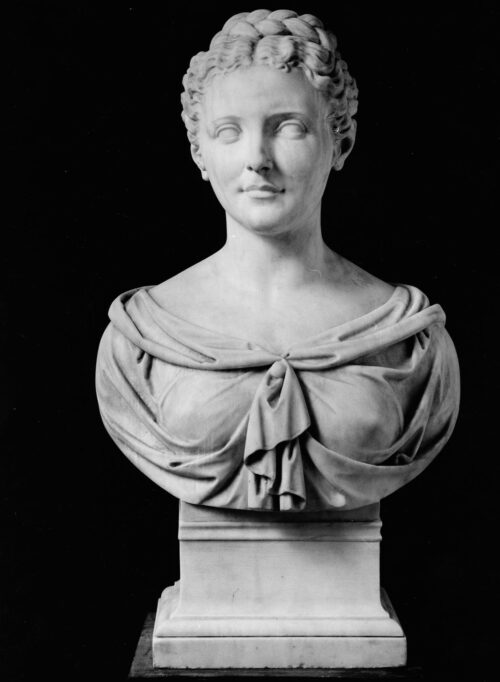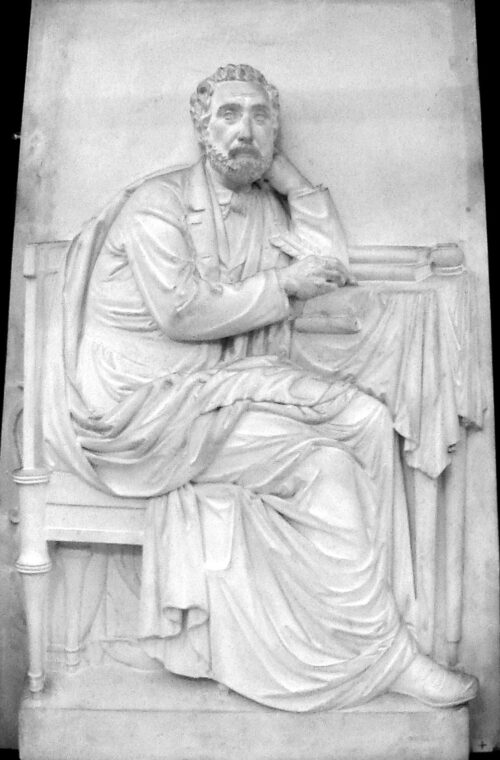
Fytalis Lazaros (1831 - 1909)
Bust of a Woman, 1883
Descendant of a great family of artists, he enrolled in the School of Arts in 1846 and studied sculpture with Christian Siegel. While still student, he worked with his brother Georgios, producing works in various parts of Greece. In 1856, the two brothers participated in the Kontostavleios competition and shared the first award of one thousand drachmas for their work Shepherd carrying a kid. In 1858, they established their own studio, which became a true school for many of the sculptors of the younger generation.
Lazaros Fytalis graduated from the School of Arts in 1851 and a few years later went to Paris, where he worked with the French sculptor Charles Cordier. In 1857, he participated in the international competition for the Wellington memorial to be built in London. In 1879, he participated in the excavation that brought to light the Lion monument at Chaironeia and subsequently submitted a plan for its restoration, which was not adopted. During 1902-1904, though, on Lazaros Sochos’s initiative, Lazaros Fytalis did participate in the restoration of the monument; in 1884, he was assigned with the conservation of the Kerameikos Bull.
The joint exhibition activity of the Fytalis brothers includes contributions to group exhibitions in Greece and international ones. Their works were shown at the London International Exhibitions in 1851 and 1862, in the 1855 and 1857 Paris International Exhibition (Lazaros’s only) as well as in the Olympia exhibitions in Athens in 1859, when they received a prize, and 1870, when they received an honorary distinction for their work as marble importers.
With their studies at the School of Arts and their familiarity with European sculpture, the Fytalis brothers had at their disposal a wide array of models from which to draw from and create compositions on mythological, allegorical and genre themes, funerary monuments, statues and busts. The works emanating from their studio are characterized by their commitment to the neoclassicist ideals, their idealistic and idealized expression as well as their adoption of realistic elements. The latter are more frequent in Georgios Fytalis’s compositions, also distinguished for their plasticity, the equilibrium of forms and the overall absence of any cold neoclassicism; in Lazaros’s work, however, idealistic features and a precise draftsmanship prevail.

Bust of a Woman, 1883

Filippos Ioannou (plaster cast from the family tomb of Filippos Ioannou in the First Cemetery of Athens, 1881

We use cookies to make our site work properly, to personalize content and ads, to provide social media features and to analyze our traffic. We also share information about how you use our site with our social media, advertising and analytics partners. Read the Cookies Policy.
These cookies are necessary for the website to function and cannot be switched off in our systems. They are usually only set in response to actions made by you which amount to a request for services, such as setting your privacy preferences, logging in or filling in forms. You can set your browser to block or alert you about these cookies, but some parts of the site will not then work. These cookies do not store any personally identifiable information.
If you disable this cookie, we will not be able to save your preferences. This means that every time you visit this website you will need to enable or disable cookies again.
These cookies tell us about how you use the site and they help us to make it better. For example these cookies count the number of visitors to our website and see how visitors move around when they are using it. This helps us to improve the way our site works, for example, by ensuring that users find what they are looking for easily. Our website uses Google Analytics for statistics reporting.
Please enable Strictly Necessary Cookies first so that we can save your preferences!